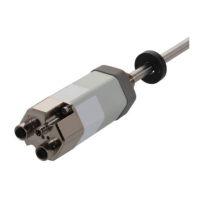www.balluff.com 7english
EtherNet/IP is an open standard for industrial networks.
It was introduced in 2001 and is the extension of the
Ethernet to the industrial protocol CIP (Common Industrial
Protocol). CIP is standardized in IEC61158 and has long
been established as the application level for automation
applications at DeviceNet, CompoNet and ControlNet.
ODVA is the organization that administrates the
technologies involving CIP. This also includes the
CIPSafety, CIPMotion and CIPSync extensions.
Based on the protocols coming from computer
networking, TCP (Transmission Control Protocol) and UDP
(User Datagram Protocol), EtherNet/IP uses CIP as the
application layer. EtherNet/IP networks offer an extensive
range of messages and services for many automation
applications, such as real-time controls, time
synchronization and motion control (Motion). The open
network standard uses generally available Ethernet
communication products for real-time I/O messages,
information exchange and general messages.
Most of the network components used correspond with
those of Ethernet components from the world of PC and
Internet.
3
EtherNet/IP and CIP basics
3.1 EtherNet/IP protocol
EtherNet/IP is orientated towards the OSI model (Open
System Interconnection), which defines a network protocol
in layers.
The lower layers are adapted to the respective bus system.
In the case of EtherNet/IP, these are the layers known from
the Ethernet. EtherNet/IP implements the CIP in the top
layers.
Ethernet is a network based on an active infrastructure.
Standard networks are usually based on a passive
infrastructure, which limits the network expansion,
number of subscribers and their connection type. The
EtherNet/IP infrastructure supports a virtually unlimited
number of end points in a number of topologies, which
allows greater flexibility in planning networks that can
subsequently be extended as required.
EtherNet/IP networks only require an access point for
configuration and control. Communication takes place via
I/O (implicit) messages that contain time-critical data and
explicit messages that contain the configuration, protocol
and service data. Various communication hierarchies and
message priorities are supported. The networks can be
used both as master/slave and for point-to-point
connections.
An EtherNet/IP telegram can contain up to 1500 bytes of
data. Each device has a six byte long MAC address. This
is used to code the sender address (SA) and destination
address (DA) of the message in each telegram. If the
highest value bit of the destination address is1, this
package is sent to several addresses.
Various EtherNet/IP networks can be combined with each
other with suitable bridges and routers. This means that
messages can be exchanged between DeviceNet and
EtherNet/IP using an appropriate router.
3.2 Object directory
In the CIP protocol family, there is a large collection of
mutually defined objects (currently 46object classes). Only
a few are specific to the protocol - all others are mutual
objects and are used in all three networks. Future objects
will be added with extensions to the functionalities. This
means that the devices can be scaled particularly well.
BTL7-V50D-…
Configuration Manual

